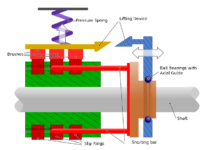Electrical Slip Ring, All You Need to Know

The tendency to get a data connection at a good pace, particularly within the mechanization industry, needs slip rings. In which these slip rings should be able to enhance the transmission of power and increase data connection. In this article, you will get to know what slip rings are and how they operate in the process of signal and power transmission? What is a slip ring? A slip ring is an electromechanical device that helps transmit electric power, analog signals, and digital signals. And these are transmitted from stationary segments of the machine to a rotating part of the machine. It provides a good electrical connection to control circuits and for transferring influential electrical signals and data. Slip rings comprise five (5) components that work together to give a fast and flawless connection for electric and rotating devices. The components of an electrical slip ring are; housing or casing, rotor, a stationary or fixed brush, a conductor ring, and ball bearings.






